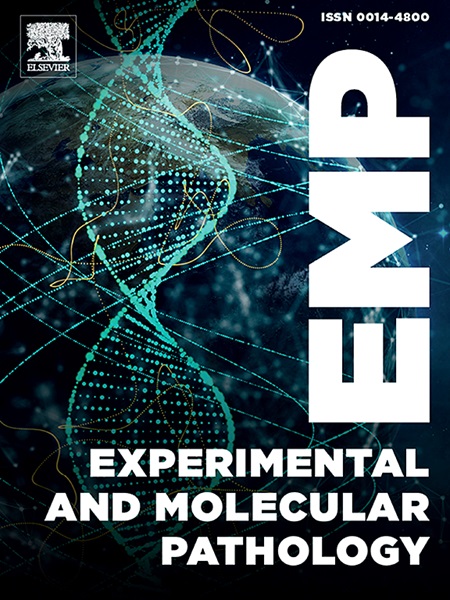过氧化物酶表达在瘤内毛细血管和靠近透明细胞肾细胞癌的近端小管细胞中增加。
IF 3.7
4区 医学
Q2 PATHOLOGY
引用次数: 0
摘要
过氧化物酶(PXDN)是一种血红素过氧化物酶,在IV型胶原的交联中起关键作用,对基底膜的完整性至关重要。PXDN过表达与许多癌症的不良临床结果相关;然而,目前对其在肾细胞癌(RCC)中的作用知之甚少。在这项研究中,我们用免疫组织化学方法表征了PXDN在透明细胞肾细胞癌(ccRCC)、憎色肾细胞癌(chRCC)和肾癌细胞瘤的肿瘤组织和邻近非肿瘤组织中的表达。我们的研究结果显示,与其他类型的肿瘤(包括嗜瘤细胞瘤)相比,ccRCC的肿瘤内毛细血管中PXDN的表达增加。此外,与癌细胞瘤的相同区域相比,ccRCC病例中非肿瘤性相邻实质近端小管上皮细胞的PXDN表达明显增加。这些发现首次表明,PXDN可能在肿瘤血管生成中发挥作用,可能促进转移和恶性肿瘤。此外,PXDN可能参与肿瘤和邻近组织之间的串扰,这一机制值得进一步研究。本文章由计算机程序翻译,如有差异,请以英文原文为准。
Peroxidasin expression is increased in intratumoural capillaries and in proximal tubular cells adjacent to clear cell renal cell carcinoma.
Peroxidasin (PXDN), is a heme peroxidase with a critical role in the crosslinking of type IV collagen, being essential for basement membrane integrity. Overexpression of PXDN has been associated with poor clinical outcomes in many cancers; however, little is currently known about its role in renal cell carcinoma (RCC). In this study, we characterized the expression of PXDN in tumour tissue and adjacent non-neoplastic tissue from cases of clear cell renal cell carcinoma (ccRCC), chromophobe RCC (chRCC), and renal oncocytoma using immunohistochemistry. Our results revealed increased PXDN expression in the intratumoural capillaries of ccRCC compared to other tumour types, including oncocytoma. Additionally, there was a notable increase in PXDN expression in the proximal tubular epithelial cells of non-neoplastic adjacent parenchyma in ccRCC cases compared to the same region in oncocytomas. These findings suggest, for the first time, that PXDN may play a role in tumour angiogenesis, potentially promoting metastases and malignancy. Furthermore, PXDN may be involved in the crosstalk between the tumour and adjacent tissues, a mechanism warranting further investigation.
求助全文
通过发布文献求助,成功后即可免费获取论文全文。
去求助
来源期刊
CiteScore
8.90
自引率
0.00%
发文量
78
审稿时长
11.5 weeks
期刊介绍:
Under new editorial leadership, Experimental and Molecular Pathology presents original articles on disease processes in relation to structural and biochemical alterations in mammalian tissues and fluids and on the application of newer techniques of molecular biology to problems of pathology in humans and other animals. The journal also publishes selected interpretive synthesis reviews by bench level investigators working at the "cutting edge" of contemporary research in pathology. In addition, special thematic issues present original research reports that unravel some of Nature''s most jealously guarded secrets on the pathologic basis of disease.
Research Areas include: Stem cells; Neoangiogenesis; Molecular diagnostics; Polymerase chain reaction; In situ hybridization; DNA sequencing; Cell receptors; Carcinogenesis; Pathobiology of neoplasia; Complex infectious diseases; Transplantation; Cytokines; Flow cytomeric analysis; Inflammation; Cellular injury; Immunology and hypersensitivity; Athersclerosis.

 求助内容:
求助内容: 应助结果提醒方式:
应助结果提醒方式:


